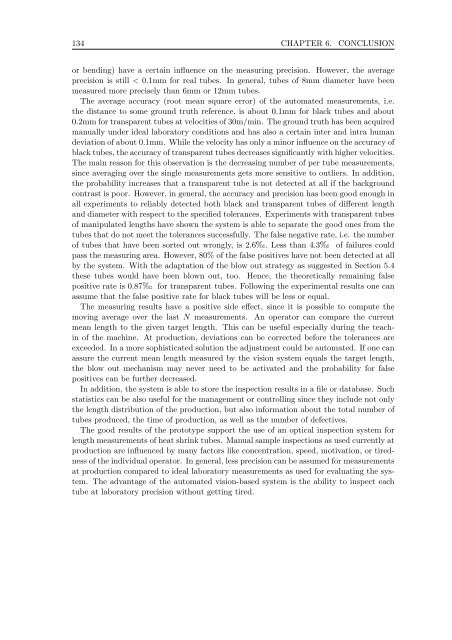Master Thesis - Fachbereich Informatik
Master Thesis - Fachbereich Informatik
Master Thesis - Fachbereich Informatik
You also want an ePaper? Increase the reach of your titles
YUMPU automatically turns print PDFs into web optimized ePapers that Google loves.
134 CHAPTER 6. CONCLUSION<br />
or bending) have a certain influence on the measuring precision. However, the average<br />
precision is still < 0.1mm for real tubes. In general, tubes of 8mm diameter have been<br />
measured more precisely than 6mm or 12mm tubes.<br />
The average accuracy (root mean square error) of the automated measurements, i.e.<br />
the distance to some ground truth reference, is about 0.1mm for black tubes and about<br />
0.2mm for transparent tubes at velocities of 30m/min. The ground truth has been acquired<br />
manually under ideal laboratory conditions and has also a certain inter and intra human<br />
deviation of about 0.1mm. While the velocity has only a minor influence on the accuracy of<br />
black tubes, the accuracy of transparent tubes decreases significantly with higher velocities.<br />
The main reason for this observation is the decreasing number of per tube measurements,<br />
sinceaveragingoverthesinglemeasurementsgetsmoresensitivetooutliers.Inaddition,<br />
the probability increases that a transparent tube is not detected at all if the background<br />
contrast is poor. However, in general, the accuracy and precision has been good enough in<br />
all experiments to reliably detected both black and transparent tubes of different length<br />
and diameter with respect to the specified tolerances. Experiments with transparent tubes<br />
of manipulated lengths have shown the system is able to separate the good ones from the<br />
tubes that do not meet the tolerances successfully. The false negative rate, i.e. the number<br />
of tubes that have been sorted out wrongly, is 2.6 .Lessthan4.3 of failures could<br />
pass the measuring area. However, 80% of the false positives have not been detected at all<br />
by the system. With the adaptation of the blow out strategy as suggested in Section 5.4<br />
these tubes would have been blown out, too. Hence, the theoretically remaining false<br />
positive rate is 0.87 for transparent tubes. Following the experimental results one can<br />
assume that the false positive rate for black tubes will be less or equal.<br />
The measuring results have a positive side effect, since it is possible to compute the<br />
moving average over the last N measurements. An operator can compare the current<br />
mean length to the given target length. This can be useful especially during the teachin<br />
of the machine. At production, deviations can be corrected before the tolerances are<br />
exceeded. In a more sophisticated solution the adjustment could be automated. If one can<br />
assure the current mean length measured by the vision system equals the target length,<br />
the blow out mechanism may never need to be activated and the probability for false<br />
positives can be further decreased.<br />
In addition, the system is able to store the inspection results in a file or database. Such<br />
statistics can be also useful for the management or controlling since they include not only<br />
the length distribution of the production, but also information about the total number of<br />
tubesproduced,thetimeofproduction,aswellasthenumberofdefectives.<br />
The good results of the prototype support the use of an optical inspection system for<br />
length measurements of heat shrink tubes. Manual sample inspections as used currently at<br />
production are influenced by many factors like concentration, speed, motivation, or tiredness<br />
of the individual operator. In general, less precision can be assumed for measurements<br />
at production compared to ideal laboratory measurements as used for evaluating the system.<br />
The advantage of the automated vision-based system is the ability to inspect each<br />
tube at laboratory precision without getting tired.














